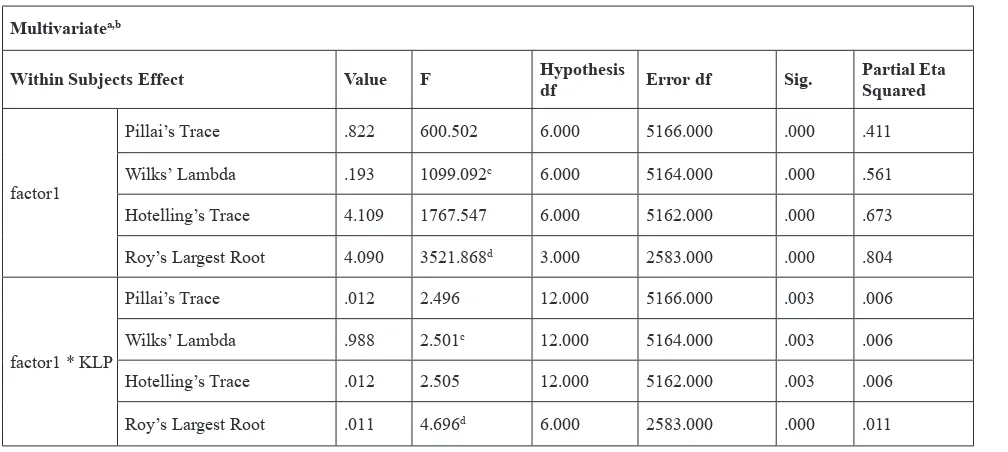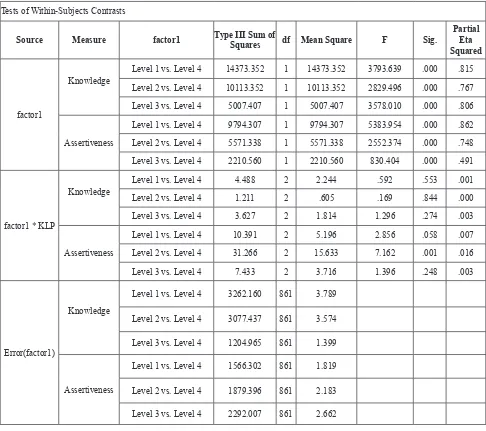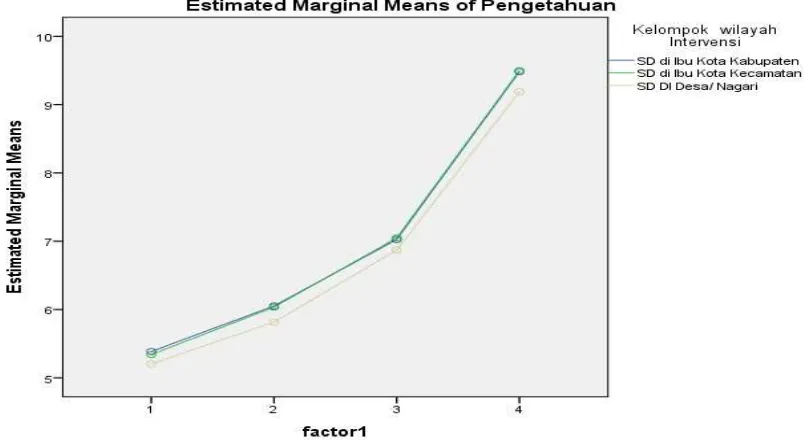The Effectiveness of “Neherta” Model as Primary Prevention
of Sexual Abuse against Primary School Children in West
Sumatera Indonesia 2017
Yonrizal Nurdin1,Meri Neherta1, Dilgu Meri2
1Faculty of Nursing Andalas University Padang Sumatera Barat Indonesia 2Master of Nursing Faculty of Nursing Andalas University Padang Indonesia
ABSTRACT
Background: sexual abuse against elementary school children occurs in many countries around the world, including Indonesia. A module of “ Neherta “ model is one of intervention model of sexual abuse prevention that can be provided for primary school children. Aim & Objective: To know the effectiveness intervention Module of sexual abuse prevention against Children from “Neherta” model. Material &Method: Research Design Quasi-Experiments type Times Series Design with 864 samples. The study was conducted in Batusangkar City from Mei 2017 to November 2017. Data is analyzed using average grade of knowledge and attitudes of primary school-aged children. it proved by the results of multivariate tests, with a value of P = 0.00. Conclusions: Modules of the “Neherta” model proved to be effective increasing the average value of knowledge and elementary school-aged children’s assertiveness in West Sumatra. It is recommended to test the module from the “Neherta” model in elementary school children outside West Sumatra.
Keywords: Neherta model, sexual violence, elementary school age children, intervention.
INTRODUCTION
Primary prevention by providing direct intervention
to children in a school-based are efficient and effective.
this is effective because it will involve several prevention strategies, such as community, teachers, students, parents and other environments around (1, 2).
one of the effective intervention modules is “Neherta” model which is made through the long stage as a result of doctoral dissertation(3).
The module of “Neherta” model is one of the best intervention modules to increase knowledge and assertiveness of school-age children(3). The learning
method of this model based on school-age characteristics which are love to play and sing. it uses presentations, story discussions, pictorial sketches, video, roleplay,
leaflet and singing with a minangkabau lyric as the
learning media “Neherta” The learning method of this
model based on school-age characteristics which are love to play and sing. it uses presentations, story discussions,
pictorial sketches, video, roleplay, leaflet and singing
with a minangkabau lyric as the learning media (3).. with
a variety of learning, media will make them enjoy the lesson. therefore the purpose of this research is to see the effectiveness of “Neherta” model toward elementary school students in West Sumatra
MATERIAL AND METHOD
This is quantitative research using quasi-experiments design with times series design. the population in this study are all the elementary student in West Sumatra with +819660 students. the sample in this study based on a krejcie table with 5% error is 864 students. The sample was selected randomly with multistage random sampling framework, ranging from a city, and sub-district and Nagari. The sample selected by purposive sampling, it only take students on the 3rd year, 4th year and 5th year, with inclusion criteria: respondents always attend the class, health both physical and spiritual
The intervention did 3 times for 2 months with 4
DOI Number: 10.5958/0976-5506.2018.01385.2
Corresponding author:
Ns. Yonrizal Nurdin, M. Biomed
times measurement, they are the average of knowledge and the average of assertive attitude from the respondent. the data were analyzed by general linear model repeated measure. this study done in elementary school in West Sumatra for 9 months, started in mei until November 2017. this study was funded by the research unit of nursing faculty of Andalas University
Respondents are divided into 3 groups a. respondent that came from district/city area b. respondent that came from sub-district area c. respondent that came from Nagari
- all groups are given the same intervention using “Neherta” model
- the interventions are given by teachers from their school
- All teachers that give the intervention have been trained
- the interventions are given 3 times for 2 months with 4 4 times of measurement,: pre-intervention
measurement, after the first intervention, after the second
interventions, and after the last intervention
The intervention of knowledge that given to children are
- 4 important and secret part of their body - they are allowed to say “no”
- the seduction pattern used by the sex offender
- perpetrators of sexual abuse against children - what should their do if they have been victimized(3)
FINDINGS
this study followed by 864 respondents and divided into three groups, the 1st group is a group that came from district/city area, the 2nd group is respondent that came from sub-district area and the last respondent is respondent that came from Nagari. the intervention is given 3 times with the same intervention, using ‘Neherta’ model. the interventions are given by their own respondent’s school teacher. All teachers that give the intervention have been trained by researcher and they gave the similar perception by researcher it takes students on the 3rd year, 4th year and 5th year. consist of 61% women and 39% men. 30% respondents are 9 years old, 38% respondents are 10 years old, 28% respondents are 11 years old and 4% respondents are 12 years old. all respondents are Muslim from normality result test using Kolmogorov-Smirnov test known that the data normally distributed, so the data processing using General Linear Model Repeated Measure analysis can be used. The data shows the increase of average value in knowledge and assertive attitudes of respondent after receiving the intervention. the increase of average value in knowledge and assertive attitudes occurred in all groups of intervention respondent. to prove the increase of average value in knowledge and assertive attitudes of these 3 groups can be seen in hypothesis test in table 1.
Table 1: Statistical test results on the average increase of Knowledge and Attitude
Assertif between the three groups of respondents in 4 times the measurement.
Multivariatea,b
Within Subjects Effect Value F Hypothesis
df Error df Sig.
Partial Eta Squared
factor1
Pillai’s Trace .822 600.502 6.000 5166.000 .000 .411
Wilks’ Lambda .193 1099.092c 6.000 5164.000 .000 .561
Hotelling’s Trace 4.109 1767.547 6.000 5162.000 .000 .673
Roy’s Largest Root 4.090 3521.868d 3.000 2583.000 .000 .804
factor1 * KLP
Pillai’s Trace .012 2.496 12.000 5166.000 .003 .006
Wilks’ Lambda .988 2.501c 12.000 5164.000 .003 .006
Hotelling’s Trace .012 2.505 12.000 5162.000 .003 .006
Table 1 is multivariate result test, the test is to know the existence of the increase of the average value in knowledge and attitudes assertive of respondents in the three research groups. From table 4 can be seen that the increase in average knowledge and assertive attitude of respondents did rise. This increase is found in the three groups, where the increase occurs one week after getting the intervention, the p-value in the factor is 0.00.
This increase in average value continues to occur until the fourth measurement, it is after the third intervention. Interventions that given to the three groups are equally effective in increasing the average of the knowledge and assertive attitudes of the three groups. It can be seen from the p-value on the group factor * shows the value of 0.003.
Table 2: The statistical test results on the increase in average knowledge and Assertiveness in the three intervention groups, where the initial average score (before intervention) as a comparison (simple contrast
Tests of Within-Subjects Contrasts
Source Measure factor1 Type III Sum of
Squares df Mean Square F Sig.
Partial Eta Squared
factor1
Knowledge
Level 1 vs. Level 4 14373.352 1 14373.352 3793.639 .000 .815
Level 2 vs. Level 4 10113.352 1 10113.352 2829.496 .000 .767
Level 3 vs. Level 4 5007.407 1 5007.407 3578.010 .000 .806
Assertiveness
Level 1 vs. Level 4 9794.307 1 9794.307 5383.954 .000 .862
Level 2 vs. Level 4 5571.338 1 5571.338 2552.374 .000 .748
Level 3 vs. Level 4 2210.560 1 2210.560 830.404 .000 .491
factor1 * KLP
Knowledge
Level 1 vs. Level 4 4.488 2 2.244 .592 .553 .001
Level 2 vs. Level 4 1.211 2 .605 .169 .844 .000
Level 3 vs. Level 4 3.627 2 1.814 1.296 .274 .003
Assertiveness
Level 1 vs. Level 4 10.391 2 5.196 2.856 .058 .007
Level 2 vs. Level 4 31.266 2 15.633 7.162 .001 .016
Level 3 vs. Level 4 7.433 2 3.716 1.396 .248 .003
Error(factor1)
Knowledge
Level 1 vs. Level 4 3262.160 861 3.789
Level 2 vs. Level 4 3077.437 861 3.574
Level 3 vs. Level 4 1204.965 861 1.399
Assertiveness
Level 1 vs. Level 4 1566.302 861 1.819
Level 2 vs. Level 4 1879.396 861 2.183
Level 3 vs. Level 4 2292.007 861 2.662
Table 2 shows that the average increase of knowledge and assertive attitudes of respondents occurred in the three intervention groups. The increase of the average value of knowledge and attitude has begun to occur in the
second measurement, that is after getting the first intervention, this condition is proved by the value of p = 0.00, both
Table 3: The statistical test results on the increase in the average value of knowledge and assertiveness groups by group comparison.
Tests of Between-Subjects Effects
Transformed Variable: Average
Source Measure Type III Sum of
Squares df Mean Square F Sig. Partial Eta Squared
Intercept
Knowledge 41278.685 1 41278.685 59511.160 .000 .986
Assertiveness 42486.634 1 42486.634 43528.389 .000 .981
KLP
Knowledge 8.725 2 4.362 6.289 .002 .014
Assertiveness .660 2 .330 .338 .713 .001
Error
Knowledge 597.215 861 .694
Assertiveness 840.394 861 .976
Table 3, is the test results of differences between groups, it shows that there is no difference of the average increase in knowledge value and assertive attitude between the three groups, with p = 0.014 for knowledge and p = 0.001 for assertive attitudes. it means the interventions given with module from the “Neherta” model to the three groups effectively increase
the average of knowledge and assertive attitudes of the respondents to all the intervention groups.
The increasing of the average value in knowledge and the assertive attitude of the three groups can be seen in Figure 1 and Figure 2.
Figure2; Graph of average increase in value n assertive attitude of respondents, after get 3 times intervention according to 4 times the measurement
From Figure 1 and figure 2 it is clear that the
average increase in the value of knowledge and assertive attitudes of the three intervention groups.
DISCUSSION
Sexual abuse against school-aged children is increasing from year to year in various countries around the world (3-6). This sexual abuse harms the child, both
physically, financially, and psychologically. The physical
effects on children due to sexual abuse include Vaginitis, urinary tract infections, reproductive system infection (7).
While the psychological impacts are depression, social disturbance, psychiatric disorders (5) the financial impact
is the increase in expenditure on treatment of victims (8)
.Violence against children is not only harmful to children but also harm their family and country.
It will disadvantage the family, the children’s victim of sexual abuse will spend a lot of time and amount of money to treat children’s physical and psychological (9-12)
beside that it will impact the country by the increasing amount of state expenditures for the treatment of children’s victim of sexual abuse. This has been proven by research (13).
Sexual abuse against children is one of the public health issues that require its resolution, as it will have a devastating impact on society (12, 14, 15). Therefore it should
be immediately done apparent result to avoid child from sexual abuse. One of the efforts that have been done is to
provide the health education to children (3, 16).
The “Neherta” model is one of the intervention models for elementary school age children from research dissertation study and has been tested on 180 students. “Neherta” model intervention has also been carried out through research involving two different professions, nurses, and teachers. from the trials and studies by two different professions are known that the intervention of the “Neherta” model increased the knowledge and assertive attitudes of primary school-aged children.
The “Neherta” model intervention is one of the model using various teaching media (presentation, video, discussion using pictorial story sketch, role
play, leaflet and sexual abuse prevention song by using
Minangkabau, West Sumatra local language) and is set based on school-age characteristics who love to learn while playing. this Neherta model applied only in Padang the capital city of West Sumatra, to see the effectiveness of Neherta model to school-age children either in the city nor in Nagari/village, it is necessary to do another research involve the respondents from the district/city, subdistrict, and Nagari.
the statistical test results there is an increase of average knowledge and assertive attitude in the three intervention groups, where the initial average value (before the intervention) as a comparison (simple contrast ) known that the average increase of knowledge and attitudes of
assertive respondents has occurred starting from the first
week (table 5) with the p = 0.00 after receiving the
first intervention the average value of knowledge and
assertive attitude of respondents has started to rise. The increase in the average value of knowledge and assertive attitude on the three groups of respondents always increases in every measurement (table 6) p = 0.00. It can be seen clearly in Figure 1 and Figure 2.
CONCLUSION
Modules of the “Neherta Model” proved to be
effective and efficient to improve the knowledge and
elementary school students’ attitudes of assertive in West Sumatra.
Conflict of Interest: No conflict of interest arose in
this study
Source of Finding: This study was conducted using a source of funds derived from the researcher himself
Ethical Clearance: This study has passed of the medical reseach ethics of the Dr. M. Djamil Hospital Padang Indonesian.
REFERENCES
1. Domhardt M, Munzer A, Fegert JM, Goldbeck L. Resilience in Survivors of Child Sexual Abuse: A Systematic Review of the Literature. Trauma, violence & abuse. 2015;16(4):476-93.
2. Euser S, Alink LR, Tharner A, van IMH, Bakermans-Kranenburg MJ. The Prevalence of Child Sexual Abuse in Out-of-home Care: Increased Risk for Children with a Mild Intellectual Disability. Journal of applied research in intellectual disabilities : JARID. 2016;29(1):83-92.
3. Neherta M, Machmud R, Damayanti R, * A. Development and Testing of Intervention Model for Child Sexual Abuse Prevention on Primary School Children in Padang City, 2014. Indian Journal of Community Health. 2015(4):472-7%V 27.
4. Leclerc B, Smallbone S, Wortley R. Prevention
nearby: the influence of the presence of a potential
guardian on the severity of child sexual abuse.
Sexual abuse : a journal of research and treatment. 2015;27(2):189-204.
5. Leclerc B, Wortley R. Predictors of victim disclosure in child sexual abuse: Additional evidence from a sample of incarcerated adult sex offenders. Child abuse & neglect. 2015;43:104-11.
6. Jennings WG, Richards TN, Tomsich E, Gover AR. Investigating the Role of Child Sexual Abuse in Intimate Partner Violence Victimization and Perpetration in Young Adulthood From a Propensity Score Matching Approach. Journal of child sexual abuse. 2015;24(6):659-81.
7. Garrocho-Rangel A, Marquez-Preciado R, Olguin-Vivar AI, Ruiz-Rodriguez S, Pozos-Guillen A. Dentist attitudes and responsibilities concerning child sexual abuse. A review and a case report. Journal of clinical and experimental dentistry. 2015;7(3):e428-34.
8. Lewis T, McElroy E, Harlaar N, Runyan D. Does the impact of child sexual abuse differ from maltreated but non-sexually abused children? A prospective examination of the impact of child sexual abuse on internalizing and externalizing behavior problems. Child abuse & neglect. 2016;51:31-40.
9. Meinck F, Cluver LD, Boyes ME. Longitudinal Predictors of Child Sexual Abuse in a Large Community-Based Sample of South African Youth. Journal of interpersonal violence. 2015.
10. Barron IG, Miller DJ, Kelly TB. School-based child sexual abuse prevention programs: moving toward resiliency-informed evaluation. Journal of child sexual abuse. 2015;24(1):77-96.
11. Weatherred JL. Child sexual abuse and the media: a literature review. Journal of child sexual abuse. 2015;24(1):16-34.
12. Veenema TG, Thornton CP, Corley A. The public health crisis of child sexual abuse in low and middle income countries: an integrative review of the literature. International journal of nursing studies. 2015;52(4):864-81.
13. Moirangthem S, Kumar NC, Math SB. Child sexual abuse: Issues & concerns. The Indian journal of medical research. 2015;142(1):1-3.
2015;24(5):555-71.
15. Pulido ML, Dauber S, Tully BA, Hamilton P, Smith MJ, Freeman K. Knowledge Gains Following a Child Sexual Abuse Prevention Program Among Urban Students: A Cluster-Randomized Evaluation. American journal of public health.
2015;105(7):1344-50.


